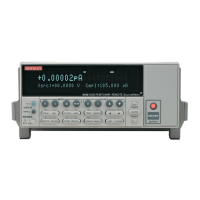11-8 Limit Testing
Sorting mode
Sorting mode limits operation is detailed by the flowchart in Figure 11-5. A test is only per-
formed if it is enabled. If disabled, operation proceeds to the next test. The following assumes
the digital output of the SourceMeter is connected to a component handler for DUT binning.
See Binning systems. If a handler is not used, ignore digital input/output (handler interface)
actions.
With the limit tests properly configured, turn the SourceMeter output on and press the
LIMIT key. The testing process will start when the component handler sends the SOT (start-of-
test) strobe pulse to the SourceMeter. Note that if a handler is not used, testing will start when
LIMIT is pressed. Pressing LIMIT a second time terminates the testing process. As shown in
the flowchart, limit tests are performed after a measurement conversion.
For Limit 1 test (compliance), a failure will display the “FAIL” message and terminate the
testing process for that DUT. For the pass condition, operation will proceed to the next enabled
limit test. If, however, there are no software limit tests (Limit 2, 3, 5-12) enabled, the testing
process will terminate and the “PASS” message will be displayed.
Assuming Limit 1 passes, each enabled software limit test will be performed until one of
them passes. When a test passes, the “PASS” message is displayed and any pending limit tests
for that DUT are cancelled. If all the limit tests fail, the “FAIL” message will be displayed.
Binning
For the sorting mode, only immediate binning can be performed. After the testing process is
finished (“FAIL” or “PASS” displayed), the appropriate output bit pattern will be sent to the
component handler which will place the DUT in the assigned bin. (The pass/fail condition can
also be queried via remote with :CALC2:LIM<n>:FAIL?.)
Using a sweep with immediate binning lets you test different devices at different source lev-
els. For example, assume a 3-point linear sweep at 1V, 2V, and 3V step levels. The first DUT is
tested at 1V, the second DUT is tested at 2V, and the third DUT is tested at 3V.

